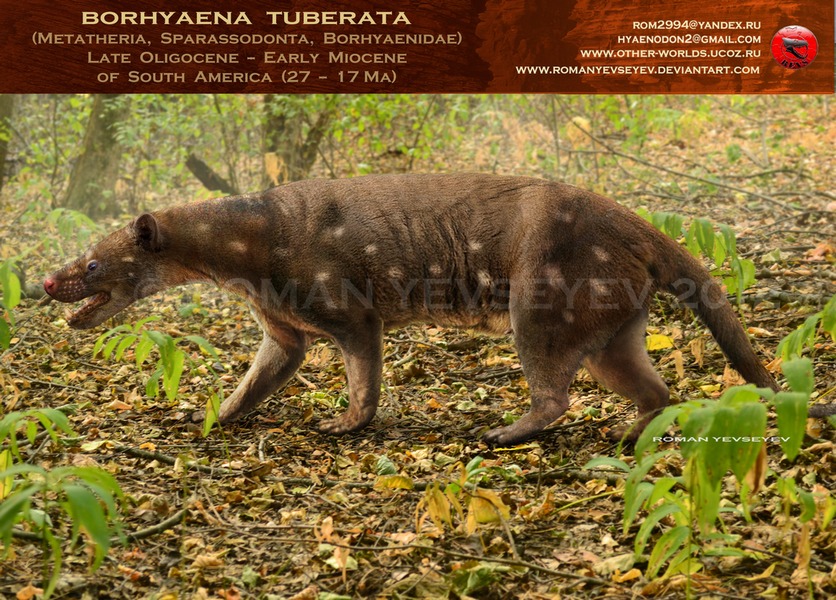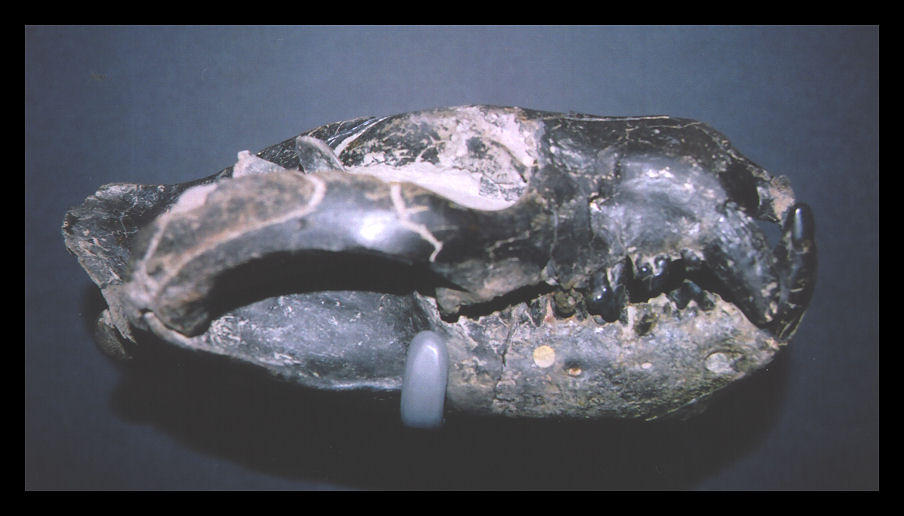Post by Infinity Blade on Jan 22, 2015 8:11:08 GMT 5
Borhyaena spp.

Life reconstruction of Borhyaena tuberata. © @ Roman Yevseyev
Temporal range: Early Miocene (20-15 Ma; Burdhigalian-Langhian)
Scientific classification:
Life
Domain: Eukaryota
(unranked): Unikonta
(unranked): Opisthokonta
(unranked): Holozoa
(unranked): Filozoa
Kingdom: Animalia
Phylum: Chordata
Subkingdom: Eumetazoa
(unranked): Bilateria
Superphylum: Deuterostomia
Phylum: Chordata
Infraphylum: Gnathostomata
Clade: Eugnathostomata
Clade: Teleostomi
Superclass: Tetrapoda
Clade: Reptiliomorpha
Clade: Amniota
Clade: Synapsida
Clade: Eupelycosauria
Clade: Sphenacodontia
Clade: Sphenacodontoidea
Order: Therapsida
Suborder: Cynodontia
Clade: Prozostrodontia
Clade: Mammaliaformes
Class: Mammalia
Legion: Cladotheria
Sublegion: Zatheria
Infralegion: Tribosphenida
Subclass: Theria
Infraclass: Metatheria
Order: †Sparassodonta
Family: †Borhyaenidae
Genus: †Borhyaena
Species: †Borhyaena tuberata
†Borhyaena macrodonta
Borhyaena is an extinct genus of predatory metatherian that lived in South America during the Miocene epoch.
Description and functional anatomy:
Borhyaena was estimated to weigh between 19-29 kilograms by Argot (2003), with 23 kilograms as the mean weight. Weight estimates based off of skull length give Borhyaena an inflated mass of 74 kilograms, failing to take Borhyaena’s proportions into account.[1]
Borhyaena had a very massive skull with large zygomatic arches. This means that it had powerful jaw muscles. This is akin to the wide zygomatic arches seen in hyenas, and Borhyaena’s skull proportions are comparable to those of the striped hyena. The cervical vertebrae point to strong development of the neck muscles. The development of the ventral processes of the cervical vertebrae indicate that the neck flexors could exert a high amount of force, suggesting the predatory habits of Borhyaena. The neural process of the axis was posteriorly expanded, suggesting that Borhyaena could violently shake its head after prey apprehension in the jaws, just like some extant predators. The cervical vertebrae’s long cervical neural processes show that the neck extensors were well developed, and this was related to the weight of the skull. Therefore, the powerful jaw muscles of Borhyaena and the long, powerful neck prove that it could lift and carry heavy loads, particularly large prey.[1]

The powerful skull of B. tuberata. © @ DeviantArt user thylobscene
Not only did Borhyaena have powerful jaw muscles, but it also had robust teeth with bulbous roots and robust, deep, and sometimes even fused dentaries. This suggests that Borhyaena was specialized for bone-cracking to some extent, although it was probably less specialized for it than extant hyenas.[2]
The postcranial skeleton of Borhyaena give insights into its lifestyle. The distal portion of Borhyaena’s humerus suggests that the forearm was restricted to the parasagittal plane. Moreover, the radius’ morphology suggests a reduced capacity for pronation and supination. Borhyaena’s manus was semi- or fully-digitigrade. The bone cores of the claws were comparatively rounded in cross section and not particularly deep; the tips had clefts and were not sharp (this suggests that the jaws were the only weapon that Borhyaena had to its disposal). Lastly, the distal limb segments were lightened with the muscle mass more concentrated in the proximal regions. All of these are adaptations for a cursorial lifestyle, although Borhyaena was less specialized for such a lifestyle than Canis or Thylacinus (e.g. the lumbar vertebrae had relatively reduced flexibility).[1]
References:
[1] Argot, C. (2003). Functional Adaptations of the Postcranial Skeleton of Two Miocene Borhyaenoids (Mammalia, Metatheria), Borhyaena and Prothylacinus, from South America.
[2] Kay, R.F., Bargo, M.S. (2012). Early Miocene Paleobiology in Patagonia: High-Latitude Paleocommunities of the Santa Cruz Formation p. 180. Cambridge University Press.

Life reconstruction of Borhyaena tuberata. © @ Roman Yevseyev
Temporal range: Early Miocene (20-15 Ma; Burdhigalian-Langhian)
Scientific classification:
Life
Domain: Eukaryota
(unranked): Unikonta
(unranked): Opisthokonta
(unranked): Holozoa
(unranked): Filozoa
Kingdom: Animalia
Phylum: Chordata
Subkingdom: Eumetazoa
(unranked): Bilateria
Superphylum: Deuterostomia
Phylum: Chordata
Infraphylum: Gnathostomata
Clade: Eugnathostomata
Clade: Teleostomi
Superclass: Tetrapoda
Clade: Reptiliomorpha
Clade: Amniota
Clade: Synapsida
Clade: Eupelycosauria
Clade: Sphenacodontia
Clade: Sphenacodontoidea
Order: Therapsida
Suborder: Cynodontia
Clade: Prozostrodontia
Clade: Mammaliaformes
Class: Mammalia
Legion: Cladotheria
Sublegion: Zatheria
Infralegion: Tribosphenida
Subclass: Theria
Infraclass: Metatheria
Order: †Sparassodonta
Family: †Borhyaenidae
Genus: †Borhyaena
Species: †Borhyaena tuberata
†Borhyaena macrodonta
Borhyaena is an extinct genus of predatory metatherian that lived in South America during the Miocene epoch.
Description and functional anatomy:
Borhyaena was estimated to weigh between 19-29 kilograms by Argot (2003), with 23 kilograms as the mean weight. Weight estimates based off of skull length give Borhyaena an inflated mass of 74 kilograms, failing to take Borhyaena’s proportions into account.[1]
Borhyaena had a very massive skull with large zygomatic arches. This means that it had powerful jaw muscles. This is akin to the wide zygomatic arches seen in hyenas, and Borhyaena’s skull proportions are comparable to those of the striped hyena. The cervical vertebrae point to strong development of the neck muscles. The development of the ventral processes of the cervical vertebrae indicate that the neck flexors could exert a high amount of force, suggesting the predatory habits of Borhyaena. The neural process of the axis was posteriorly expanded, suggesting that Borhyaena could violently shake its head after prey apprehension in the jaws, just like some extant predators. The cervical vertebrae’s long cervical neural processes show that the neck extensors were well developed, and this was related to the weight of the skull. Therefore, the powerful jaw muscles of Borhyaena and the long, powerful neck prove that it could lift and carry heavy loads, particularly large prey.[1]

The powerful skull of B. tuberata. © @ DeviantArt user thylobscene
Not only did Borhyaena have powerful jaw muscles, but it also had robust teeth with bulbous roots and robust, deep, and sometimes even fused dentaries. This suggests that Borhyaena was specialized for bone-cracking to some extent, although it was probably less specialized for it than extant hyenas.[2]
The postcranial skeleton of Borhyaena give insights into its lifestyle. The distal portion of Borhyaena’s humerus suggests that the forearm was restricted to the parasagittal plane. Moreover, the radius’ morphology suggests a reduced capacity for pronation and supination. Borhyaena’s manus was semi- or fully-digitigrade. The bone cores of the claws were comparatively rounded in cross section and not particularly deep; the tips had clefts and were not sharp (this suggests that the jaws were the only weapon that Borhyaena had to its disposal). Lastly, the distal limb segments were lightened with the muscle mass more concentrated in the proximal regions. All of these are adaptations for a cursorial lifestyle, although Borhyaena was less specialized for such a lifestyle than Canis or Thylacinus (e.g. the lumbar vertebrae had relatively reduced flexibility).[1]
References:
[1] Argot, C. (2003). Functional Adaptations of the Postcranial Skeleton of Two Miocene Borhyaenoids (Mammalia, Metatheria), Borhyaena and Prothylacinus, from South America.
[2] Kay, R.F., Bargo, M.S. (2012). Early Miocene Paleobiology in Patagonia: High-Latitude Paleocommunities of the Santa Cruz Formation p. 180. Cambridge University Press.






